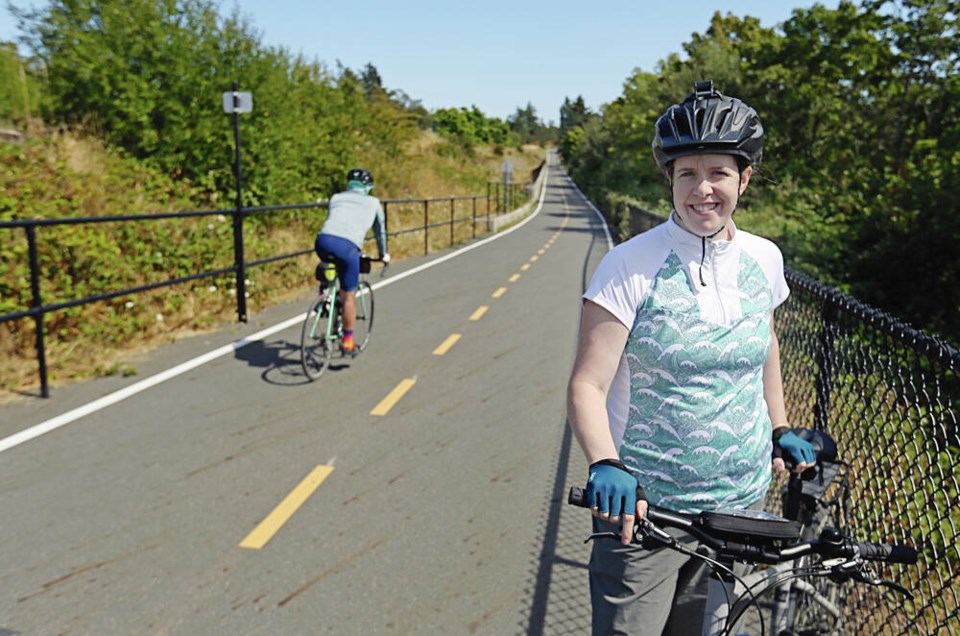An incident this week where a pedestrian was hit by an e-bike on the Galloping Goose Trail is a reminder of the dangers of increasingly crowded multi-use trails, where some people travel at high speeds, says a cyclist.
The incident occurred Wednesday near Regatta Landing, where the trail has two-way bike lanes and a walking path, but there’s no physical barrier separating them. Victoria police said the bike involved was electric but couldn’t say whether speed was a factor or what led to the crash.
Susan Low, who started cycling regularly on the region’s multi-use trails about two years ago, commuting from View Royal to downtown on the E&N Rail Trail, said she sometimes feels nervous on the region’s trails because of the speeds of some e-bikes, electric unicycles and scooters.
Some of the bikes she’s seen appear to not require any pedalling to allow them to reach high speeds, and she questions whether those types of vehicles belong on the trails.
She said she understands that people may not feel comfortable riding on the road, but that if they choose the trails, they should be travelling at speeds possible for human-powered bikes, not speeds only possible with a motor.
“I worry with these e-bikes, especially because they’re so heavy. I worry that their stopping distance is much farther than the riders think it is,” she said.
Low said she averages about 20 kilometres an hour, and probably ranges from about 10 to 30 kilometres per hour if she’s going up or downhill. She said she is often passed by people who seem to be moving significantly faster, many of whom give no warning before passing her closely.
“I’m not the steadiest cyclist yet. If I wobble or something like that, or if I’m going around an obstacle, I can easily get hit by one of them coming from behind me,” she said.
Low said she’s not very comfortable cycling on the road and appreciates the all ages and abilities approach to trails in the region.
But she’d like to see more education around trail etiquette, or a speed radar sign to remind people to watch their speeds on the busiest parts of the trails.
“I know we have a lot of really great cyclists in Victoria. And I live with someone who’s a really good cyclist and he knows where to use the speed and where to slow it down. And that’s part of being a responsible user of the trail. You cannot whip along at top speed in the crowded areas,” she said.
Amanda Macdonald, chair of pedestrian advocacy group Walk On Victoria, said when the group does surveys, people often report nearly being hit by bikes. Macdonald said the issue is not about pitting people on bikes against people on foot, but about the lack of infrastructure for both types of vulnerable road users.
“Maybe the question is more like, ‘Well, why are we giving cars all the safe space and forcing us onto this little side?’ When maybe if there were more bike lanes on the roads — separated bike lanes — then that would kind of give more room for pedestrians to have that space,” she said.
A physical barrier on busy sections of the trails, like a strip of grass or bollards, and a speed limit could also help reduce conflict between pedestrians and cyclists, she said.
The Capital Regional District said there is no speed limit on regional trails. But provincial regulations say the maximum allowed speed for an e-bike on level ground is 32 km/h.
The CRD launched its annual trail etiquette campaign Cruise with Courtesy in mid-July. During the campaign, which runs to September, CRD regional parks rangers, park naturalists and bylaw officers visit some of the busiest sections of multi-use trails to remind people to control their speed, yield to pedestrians and alert others when passing.
The CRD has been working toward a project to widen and light busy sections of the Galloping Goose and Lochside trails.
In August, the CRD board will consider whether to go ahead with the project, which would see sections of the Goose from the Selkirk Trestle to Grange Road and the Lochside trail between the Switch Bridge near Uptown and McKenzie Avenue/Borden Street, expanded to 6.5 metres wide with separate lanes for pedestrians and cyclists.
>>> To comment on this article, write a letter to the editor: [email protected]



